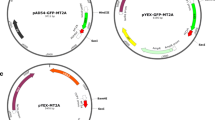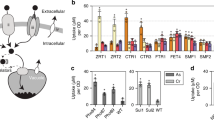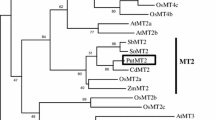Abstract
Accumulation of heavy metals without developing toxicity symptoms is a phenotype restricted to a small group of plants called hyperaccumulators, whose metal-related characteristics suggested the high potential in biotechnologies such as bioremediation and bioextraction. In an attempt to extrapolate the heavy metal hyperaccumulating phenotype to yeast, we obtained Saccharomyces cerevisiae cells armed with non-natural metal-binding hexapeptides targeted to the inner face of the plasma membrane, expected to sequester the metal ions once they penetrated the cell. We describe the construction of S. cerevisiae strains overexpressing metal-binding hexapeptides (MeBHxP) fused to the carboxy-terminus of a myristoylated green fluorescent protein (myrGFP). Three non-toxic myrGFP-MeBHxP (myrGFP-H6, myrGFP-C6, and myrGFP-(DE)3) were investigated against an array of heavy metals in terms of their effect on S. cerevisiae growth, heavy metal (hyper) accumulation, and capacity to remove heavy metal from contaminated environments.






Similar content being viewed by others
Reference
Amberg DC, Burke DJ, Strathern JN (2005) “Quick and dirty” plasmid transformation of yeast colonies. In: Burke D, Dawson D, Stearns T (eds) Methods in yeast genetics. A Cold Spring Harbor laboratory course manual. Cold Spring Harbor Laboratory Press, Cold Spring Harbor, pp 113–114
Blaby-Haas CE, Merchant SS (2014) Lysosome-related organelles as mediators of metal homeostasis. J Biol Chem 289:28129–28136
Brachmann CB, Davies A, Cost GJ, Caputo E, Li J, Hieter P, Boeke JD (1998) Designer deletion strains derived from Saccharomyces cerevisiae S288C: a useful set of strains and plasmids for PCR-mediated gene disruption and other applications. Yeast 14:115–132
Bradford MM (1976) A rapid and sensitive method for the quantitation of microgram quantities of protein utilizing the principle of protein-dye binding. Anal Biochem 72:248–254
Bradl H (ed) (2002) Heavy metals in the environment: origin, interaction and remediation, vol 6. Academic, London
Brady D, Stoll AD, Starke L, Duncan JR (1994) Chemical and enzymatic extraction of heavy metal binding polymers from isolated cell walls of Saccharomyces cerevisiae. Biotechnol Bioeng 44:297–302
Cohen R, Engelberg D (2007) Commonly used Saccharomyces cerevisiae strains (e.g. BY4741, W303) are growth sensitive on synthetic complete medium due to poor leucine uptake. FEMS Microbiol Lett 273:239–243
Dalcorso G, Fasani E, Furini A (2013) Recent advances in the analysis of metal hyperaccumulation and hypertolerance in plants using proteomics. Front Plant Sci 4:280
Dürr G, Strayle J, Plemper R, Elbs S, Klee SK, Catty P, Wolf DH, Rudolph HK (1998) The medial-Golgi ion pump Pmr1 supplies the yeast secretory pathway with Ca2+ and Mn2+ required for glycosylation, sorting, and endoplasmic reticulum-associated protein degradation. Mol Biol Cell 9:1149–1162
Egel-Mitani M, Andersen AS, Diers I, Hach M, Thim L, Hastrup S, Vad K (2000) Yield improvement of heterologous peptides expressed in yps1-disrupted Saccharomyces cerevisiae strains. Enzym Microb Technol 26:671–677
Eide DJ (2003) Multiple regulatory mechanisms maintain zinc homeostasis in Saccharomyces cerevisiae. J Nutr 133:1532S–1535S
Eide DJ (2009) Homeostatic and adaptive responses to zinc deficiency in Saccharomyces cerevisiae. J Biol Chem 284:18565–18569
Farcasanu IC, Matache M, Iordache V, Neagoe A (2012) Hyperaccumulation: a key to heavy metal bioremediation. Soil Biol 31:251–278
Feldmann H (ed) (2012) Transition metal transport. In Yeast: molecular and cell biology, 2nd edn. Wiley-Blackwell, Hoboken, pp 226–232
Francois JM (2016) Cell surface interference with plasma membrane and transport processes in yeasts. Adv Exp Med Biol 892:11–31
Georgiou G, Stathopoulos C, Daugherty PS, Nayak AR, Iverson BL, Curtiss R 3rd (1997) Display of heterologous proteins on the surface of microorganisms: from the screening of combinatorial libraries to live recombinant vaccines. Nat Biotechnol 15:29–34
Gifford S, Dunstan RH, O’Connor W, Koller CE, MacFarlane GR (2007) Aquatic zooremediation: deploying animals to remediate contaminated aquatic environments. Trends Biotechnol 25:60–65
Gillen KM, Pausch M, Dohlman HG (1998) N-terminal domain of Gpa1 (G protein α) subunit is sufficient for plasma membrane targeting in yeast Saccharomyces cerevisiae. J Cell Sci 111(Pt. 21):3235–3244
Guthrie C, Fink GR (eds) (1991) Guide to yeast genetics and molecular biology. Methods Enzymol 194:1–863
He ZL, Yang XE, Stoffella PJ (2005) Trace elements in agroecosystems and impacts on the environment. J Trace Elem Med Biol 19:125–140
Ito R, Kuroda K, Hashimoto H, Ueda M (2016) Recovery of platinum(0) through the reduction of platinum ions by hydrogenase-displaying yeast. AMB Express 6:88
Jansen G, Wu C, Schade B, Thomas DY, Whiteway M (2005) Drag&Drop cloning in yeast. Gene 344:43–51
Kambe-Honjoh H, Ohsumi K, Shimoi H, Nakajima H, Kitamoto K (2000) Molecular breeding of yeast with higher metal-adsorption capacity by expression of histidine-repeat insertion in the protein anchored to the cell wall. J Gen Appl Microbiol 46:113–117
Kotrba P, Rumi T (2010) Surface display of metal fixation motifs of bacterial P1-type ATPase specifically promotes biosorption of Pb(2+) by Saccharomyces cerevisiae. Appl Environ Microbiol 76:2615–2622
Krämer U (2005) Phytoremediation: novel approaches to cleaning up polluted soils. Curr Opin Biotechnol 16:133–141
Krämer U (2010) Metal hyperaccumulation in plants. Annu Rev Plant Biol 61:517–534
Krzciuk K, Gałuszka A (2015) Prospecting for hyperaccumulators of trace elements: a review. Crit Rev Biotechnol 35:522–532
Kuroda K, Ueda M (2003) Bioadsorption of cadmium ion by cell surface-engineered yeasts displaying metallothionein and hexa-his. Appl Microbiol Biotechnol 63:182–186
Kuroda K, Ueda M (2006) Effective display of metallothionein tandem repeats on the bioadsorption of cadmium ion. Appl Microbiol Biotechnol 70:458–463
Kuroda K, Ueda M (2010) Engineering of microorganisms towards recovery of rare metal ions. Appl Microbiol Biotechnol 87:53–60
Kuroda K, Shibasaki S, Ueda M, Tanaka A (2001) Cell surface engineered yeast displaying a histidine oligopeptide (hexa-his) has enhanced adsorption of and tolerance to heavy metal ions. Appl Microbiol Biotechnol 57:697–701
Kuroda K, Ueda M, Shibasaki S, Tanaka A (2002) Cell surface engineered yeast with ability to bind, and self-aggregate in response to, copper ion. Appl Microbiol Biotechnol 59:259–264
Kuroda K, Ebisutani K, Iida K, Nishitani T, Ueda M (2014) Enhanced adsorption and recovery of uranyl ions by NikR mutant-displaying yeast. Biomol Ther 4:390–401
Kwolek-Mirek M, Zadrag-Tecza R (2014) Comparison of methods used for assessing the viability and vitality of yeast cells. FEMS Yeast Res 14:1068–1079
Lapinskas PJ, Cunningham KW, Liu XF, Fink GR, Culotta VC (1995) Mutations in PMR1 suppress oxidative damage in yeast lacking superoxide dismutase. Mol Cell Biol 15:1382–1388
Lauer Júnior CM, Bonatto D, Mielniczki-Pereira AA, Schuch AZ, Dias JF, Yoneama ML, Pêgas Henriques JA (2008) The Pmr1 protein, the major yeast Ca2+-ATPase in the Golgi, regulates intracellular levels of the cadmium ion. FEMS Microbiol Lett 285:79–88
Leitenmaier B, Küpper H (2013) Compartmentation and complexation of metals in hyperaccumulator plants. Front Plant Sci 4:374
Liu Z, Ho SH, Hasunuma T, Chang JS, Ren NQ, Kondo A (2016) Recent advances in yeast cell-surface display technologies for waste biorefineries. Bioresour Technol 215:324–333
Machado MD, Santos MS, Gouveia C, Soares HM, Soares EV (2008) Removal of heavy metals using a brewer’s yeast strain of Saccharomyces cerevisiae: the flocculation as a separation process. Bioresour Technol 99:2107–2115
Machado MD, Janssens S, Soares HM, Soares EV (2009) Removal of heavy metals using a brewer’s yeast strain of Saccharomyces cerevisiae: advantages of using dead biomass. J Appl Microbiol 106:1792–1804
Massé E, Arguin M (2005) Ironing out the problem: new mechanisms of iron homeostasis. Trends Biochem Sci 30:462–468
Mosa KA, Saadoun I, Kumar K, Helmy M, Dhankher OP (2016) Potential biotechnological strategies for the cleanup of heavy metals and metalloids. Front Plant Sci 7:303
Murai T, Ueda M, Yamamura M, Atomi H, Shibasaki Y, Kamasawa N, Osumi M, Amachi T, Tanaka A (1997) Construction of a starch-utilizing yeast by cell surface engineering. Appl Environ Microbiol 63:1362–1366
Nakajima H, Iwasaki T, Kitamoto K (2001) Metalloadsorption by Saccharomyces cerevisiae cells expressing invertase-metallothionein (Suc2-Cup1) fusion protein localized to the cell surface. J Gen Appl Microbiol 47:47–51
Ofiteru AM, Ruta LL, Rotaru C, Dumitru I, Ene CD, Neagoe A, Farcasanu IC (2012) Overexpression of the PHO84 gene causes heavy metal accumulation and induces Ire1p-dependent unfolded protein response in Saccharomyces cerevisiae cells. Appl Microbiol Biotechnol 94:425–435
Pollard AJ, Reeves RD, Baker AJ (2014) Facultative hyperaccumulation of heavy metals and metalloids. Plant Sci 217-218:8–17
Rascio N, Navari-Izzo F (2011) Heavy metal hyperaccumulating plants: how and why do they do it? And what makes them so interesting? Plant Sci 180:169–181
Ratherford JC, Bird AJ (2004) Metal-responsive transcription factors that regulate iron, zinc, and copper homeostasis in eukaryotic cells. Eukaryot Cell 3:1–13
Reddi AR, Jensen LT, Culotta VC (2009) Manganese homeostasis in Saccharomyces cerevisiae. Chem Rev 109:4722–4732
Rosenfeld L, Reddi AR, Leung E, Aranda K, Jensen LT, Culotta VC (2010) The effect of phosphate accumulation on metal ion homeostasis in Saccharomyces cerevisiae. J Biol Inorg Chem 15:1051–1062
Ruta L, Paraschivescu C, Matache M, Avramescu S, Farcasanu IC (2010) Removing heavy metals from synthetic effluents using “kamikaze” Saccharomyces cerevisiae cells. Appl Microbiol Biotechnol 85:763–771
Sharma SS, Dietz KJ, Mimura T (2016) Vacuolar compartmentalization as indispensable component of heavy metal detoxification in plants. Plant Cell Environ 39:1112–1126
Sherman F (2002) Getting started with yeast. Methods Enzymol 350:3–41
Shibasaki S, Ueda M, Iizuka T, Hirayama M, Ikeda Y, Kamasawa N, Osumi M, Tanaka A (2001) Quantitative evaluation of the enhanced green fluorescent protein displayed on the cell surface of Saccharomyces cerevisiae by fluorometric and confocal laser scanning microscopic analyses. Appl Microbiol Biotechnol 55:471–475
Shibasaki S, Kuroda K, Duc Nguyen H, Mori T, Zou W, Ueda M (2006) Detection of protein-protein interactions by a combination of a novel cytoplasmic membrane targeting system of recombinant proteins and fluorescence resonance energy transfer. Appl Microbiol Biotechnol 70:451–457
Shibasaki S, Maeda H, Ueda M (2009) Molecular display technology using yeast–arming technology. Anal Sci 25:41–49
Soares EV (2011) Flocculation in Saccharomyces cerevisiae: a review. J Appl Microbiol 110:1–18
Soares EV, Soares HM (2012) Bioremediation of industrial effluents containing heavy metals using brewing cells of Saccharomyces cerevisiae as a green technology: a review. Environ Sci Pollut Res Int 19:1066–1083
Soares EV, Soares HM (2013) Cleanup of industrial effluents containing heavy metals: a new opportunity of valorising the biomass produced by brewing industry. Appl Microbiol Biotechnol 97:6667–6675
Van der Heggen M, Martins S, Flores G, Soares EV (2010) Lead toxicity in Saccharomyces cerevisiae. Appl Microbiol Biotechnol 88:1355–1361
Van Ho A, Ward DM, Kaplan J (2002) Transition metal transport in yeast. Annu Rev Microbiol 56:237–261
Acknowledgements
The research leading to these results has received funding from the Romanian—EEA Research Program operated by the Ministry of National Education under the EEA Financial Mechanism 2009-2014 and Project Contract No 21 SEE/30.06.2014.
Author information
Authors and Affiliations
Corresponding author
Ethics declarations
Funding
This study was funded by the EEA Financial Mechanism 2009–2014 (Contract No 21 SEE/30.06.2014).
Conflict of interest
The authors declare that they have no conflict of interest.
This article does not contain any studies with human participants or animals performed by any of the authors.
Electronic supplementary material
ESM 1
(PDF 407 kb)
Rights and permissions
About this article
Cite this article
Ruta, L.L., Kissen, R., Nicolau, I. et al. Heavy metal accumulation by Saccharomyces cerevisiae cells armed with metal binding hexapeptides targeted to the inner face of the plasma membrane. Appl Microbiol Biotechnol 101, 5749–5763 (2017). https://doi.org/10.1007/s00253-017-8335-0
Received:
Revised:
Accepted:
Published:
Issue Date:
DOI: https://doi.org/10.1007/s00253-017-8335-0




